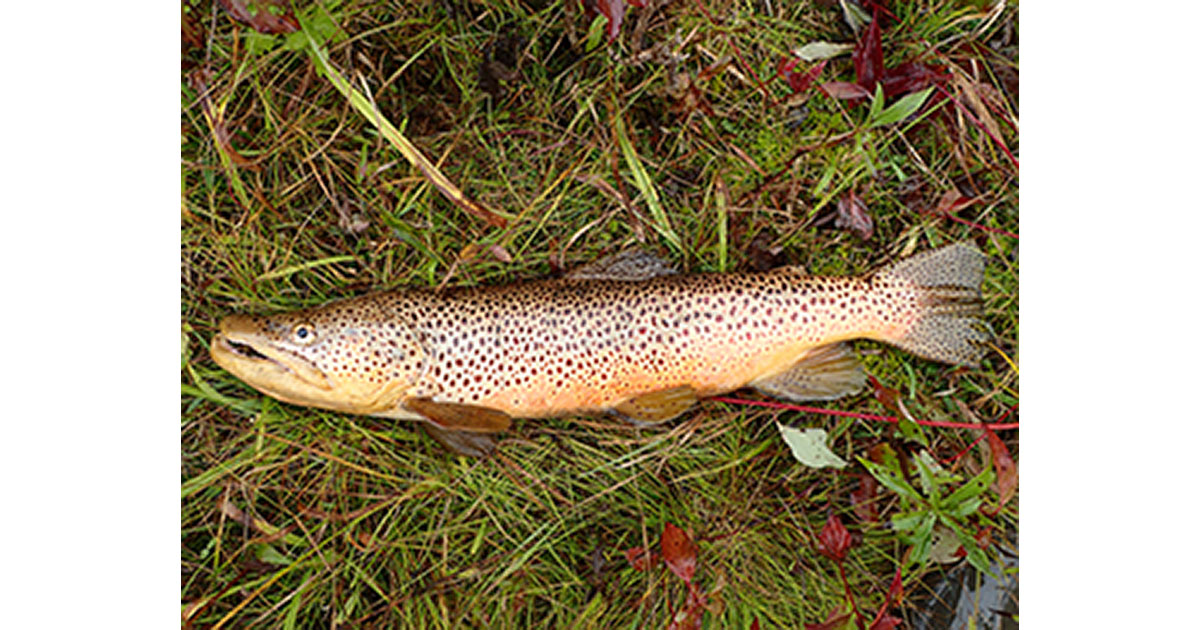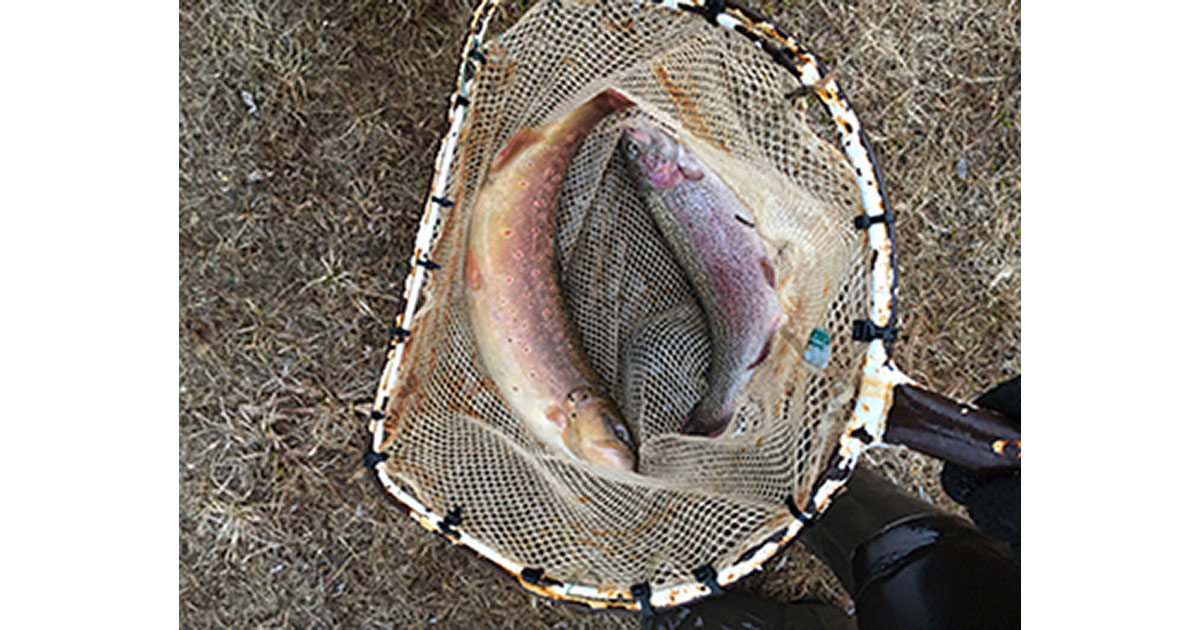- Details
MDNR Report

The Michigan Natural Resources Commission has enacted regulation changes on several inland trout lakes in the Upper Peninsula, effective Oct. 10, 2025. Four lakes have changed regulation types and four others have been removed from the list of designated trout lakes and no longer have a type designation. These changes will expand fishing opportunities for other species and better reflect the fish communities present in those waters.
The NRC, which is a public body whose members are appointed by the governor, has the exclusive authority to regulate the taking of game and sportfish in Michigan.
Michigan DNR fisheries managers use fish survey data to determine which regulations should apply to a waterbody and recommend changes to the NRC when necessary to benefit the resource and angling community.
Modifications
- High Banks Lake (Chippewa County): This lake was changed from Type A to Type B trout fishing regulations. This will extend the season to the entire year and allow the use of all tackle and bait. Per a 2023 survey, panfish are present in the lake, which has primarily been managed for rainbow trout. Changing the regulations to Type B will expand fishing opportunities here to allow anglers to use live bait to target panfish, including allowing ice fishing.
- Moon Lake (Luce County): Moon Lake has been changed from Type D to Type A trout fishing regulations to match trout growth potential with harvest opportunities. Recent survey information indicated a decline in the average size of brook trout collected. Type A trout lakes have a lower minimum size limit (10 inches) and a higher daily possession limit (up to five fish), which should result in more angler opportunities.
- South Kidney Lake (Marquette County): This waterbody was modified from Type D to Type A trout fishing regulations, informed by a survey conducted in 2024 that demonstrated stocked brook trout were not reaching the 15-inch minimum size limit, limiting angler harvest there. The change will result in a lower minimum size limit and an increase in the daily possession limit for brook trout. In addition, it will also allow use of bait in South Kidney Lake (except for minnows, which are not allowed in Type A lakes).
- Strawberry Lake (Marquette County): This lake was modified from Type D to type A trout fishing regulations to better align trout growth potential with harvest opportunities. A survey conducted in 2024 indicated that stocked brook trout in the lake are slow-growing, with few reaching the 15-inch minimum size limit. The change means a lower minimum size limit, an increase in the daily possession limit and removal of an artificial-only gear restriction for brook trout fishing.
Removals
The following waterbodies have been evaluated and found to lack adequate habitat to support stocked or naturally reproducing trout populations. Therefore, the previous trout fishing regulation types were no longer appropriate. Management in these lakes will focus on warmwater species better suited to the current conditions.
- Brians Pond (Alger County): Type A trout fishing regulations have been removed; general fishing regulations apply.
- Section 13 Lake (Marquette County): Type A trout fishing regulations have been removed; general fishing regulations apply.
- Cedar Lake (Marquette County): Type B trout fishing regulations have been removed; general fishing regulations apply.
- Sawaski Pond (Alger County): Type B trout fishing regulations have been removed; general fishing regulations apply.
These regulation changes are not reflected in the printed version of the 2025 Michigan Fishing Regulations. Anglers are reminded to check the digital version of the regulations online at Michigan.gov/DNRRegs or in the Michgan DNR Hunt Fish app for the most current regulatory information.
- Details
IDNR Report

The Indiana DNR plans to stock nearly 35,000 rainbow and brown trout across Indiana this spring in preparation for this year’s inland trout fishing season, which opens Saturday, April 26, for inland streams.
Nineteen streams across 13 counties are anticipated to receive fish before and after opening day.
Most of the lake stockings of rainbow trout were done last month, starting the week of March 24. Anglers don’t have to wait to fish for those, as trout fishing on inland lakes is open year-round.
For streams, about 21,000 rainbow trout are expected to be stocked in the days leading up to opening day. Several sites will get additional rainbow trout stockings until Memorial Day weekend.
In addition to the rainbow trout stockings, 10 bodies of water will receive brown trout stockings in May.
To find a stocked stream near you, see the 2025 trout stocking plan at on.IN.gov/fish-stocking.
Trout will bite on a variety of artificial baits such as spinners and flies, but natural baits such as worms and bee moths tend to be the most popular.
The bag limit for trout in inland waters other than Lake Michigan and its tributaries is five per day with a minimum size of 7 inches. No more than one of an angler’s catch can be a brown trout. There is no size limit for trout on inland lakes except for any harvested brown trout caught below the Brookville Lake tailwater or from Oliver, Olin or Martin lakes. Those trout must be 18 inches or larger to be kept.
To fish for trout, anglers age 18 and older need an Indiana fishing license and a trout/salmon stamp. To purchase yours for this year, visit GoOutdoorsIN.com.
- Details
By Jim Edlund

There’s an electricity in the air this time of year along the Great Lakes as anglers turn out for an annual bite that’s tough to pass up. As soon as the launches open, you’ll see all manner of small boats (and pier fisherman, too), forming lines to chase near-shore coho salmon.
Although these fish leave something to be desired in size – with most fish between a pound and 3 pounds – their table fare is excellent, with many anglers preferring the young, bright red flesh for everything from grilling and baking, to pan frying and filling up smoker racks – to the larger species that occupy the Great Lakes.
One angler who loves the annual rite is charter captain and Great Lakes Angler editor, Mike Schoonveld, of northern Indiana, who started fishing them this spring in March.
“What happens is the cohos that were two years old last fall migrate to the south end of Lake Michigan, because that’s where the water temperature stays in their comfort range the longest. Once they get down here, there’s no place to go. Then, in the spring, when the water starts to warm up, the fish that are in the southern basin of the lake storm the beaches in Indiana, southern Michigan, and the south side of Chicago, because those are the parts of the lake that warm up the quickest,” noted Schoonveld.
“Basically, what you’ve got are two-and-a-half year-old cohos in the lake crammed within a few hundred yards of the shoreline and streams,” added Schoonveld.
Where Schoonveld fishes off the Indiana coast, limits are five cohos per person, but he says you can also catch the errant brown trout, lake trout, steelhead, or Chinook salmon. And the chance of a mixed bag only increases as spring progresses. Average cohos right now are 16 or 17 inches to 22 inches – “basically eater-walleye size.”
The bite is ongoing and will last until the water temperatures reach the mid 50s, around May 1st during a typical, warm spring. The bite can last through the middle of May if temperatures stay cooler.
Even when it does warms up, Schoonveld says you don’t have to abandon the fight, just move a few miles offshore where the fish migrate to colder water. But then you lose the advantage of fishing near the shoreline and have to be cautious on what days you go out if fishing from a smaller boat.
And when the fish leave the Indiana coast, they tend to follow the shorelines up the Lake Michigan coast. There are typically fish off the north coast of Chicago by May 1st, as well as up around Kenosha and Racine, Wisconsin. The same thing happens over on the Michigan side with fish moving from St. Joseph towards Grand Haven.
Small Boat and Tackle Friendly Bite
One of the coolest things about the annual coho bite is that it’s accessible to anglers with smaller, multi-species boats, as well as pier anglers. You don’t need a large charter boat to access these fish, with a lot less worry about the weather given proximity to shore. And you won’t see a lot of large boats out on the bite either; most are still iced up where they’re moored for winter.
Plus, you don’t need downriggers to fish springtime cohos. The fish are high in the water column and susceptible to shallow-diving crankbaits fished on standard gear.
“For whatever reason, they love orange,” says Schoonveld. “There are literally millions of cohos so you can catch them on pretty much anything, but you’ll probably catch them faster if you’re using orange-colored lures – and most bite in the top several feet of water. There’s no reason to use riggers to get your baits down 15, 20, 30 feet or whatever. Most anglers are running bigger planer boards or walleye-sized line planers.”
Of all the crankbaits Schoonveld runs, his favorite is the Storm Rattlin’ Thin Fin, but says Flickr Shads and Rapalas are fish-catchers, too.
- Details
MDNR Report

Approximately 4,250 adult trout were stocked recently by the MDNR in the Huron River (Proud Lake Recreation Area, Oakland County) and Spring Mill Pond (Island Lake Recreation Area, Livingston County) in southeast Michigan. These fish are retired broodstock from Michigan’s state fish hatcheries.
- The Huron River, downstream of the Proud Lake Dam, was stocked with approximately 1,950 brown trout and 1,350 rainbow trout, all ranging in size from 13 inches to 19 inches.
- Spring Mill Pond was stocked with approximately 450 brown trout and 500 rainbow trout, also ranging from 13 inches to 19 inches.
- Details
MDNR Report
 Salmon Eggs
Salmon Eggs
Every year, the Michigan DNR stocks fish in Michigan waters to provide fishing opportunities and maintain healthy ecosystems. Where do these stocked fish come from? It all starts with collecting fish eggs, and the DNR has been working hard this fall gathering the necessary eggs to produce fish for stocking. Fall egg collections have been completed for wild Chinook and coho salmon and for captive broodstocks of brown, brook and lake trout, and rainbow trout egg collection will soon begin.
Chinook salmon eggs were collected Oct. 1–16 at the Little Manistee River Weir. Eggs and milt (sperm) are gathered from fish during the annual salmon run. At the weir, salmon swim up a fish ladder and into holding ponds. From there, fish are brought into the facility, where eggs and milt are collected and the eggs are fertilized.
“We experienced a solid run of wild Chinook salmon this year,” said Aaron Switzer, Fish Production Program manager. “The run at the Little Manistee was healthy enough to provide all of Michigan’s egg needs. We were also able to provide eggs to Indiana and Illinois state-owned fish hatcheries. Once hatched, reared and stocked all of these Chinook salmon contribute to the Lake Michigan salmon fishery.”
Coho salmon eggs were collected at the Platte River State Fish Hatchery Weir from Oct. 15 to Nov. 1.
“We collected nearly 6.5 million coho salmon eggs at the Platte River weir by the time the egg collection wrapped up. This includes approximately 3 million for Indiana, Illinois and Wisconsin. All four states work together cooperatively each year to ensure Lake Michigan continues to receive Pacific salmon to supplement the fishery,” said Switzer.
Not all egg collections are of wild fish, however. Captive broodstocks, fish kept at a hatchery to produce eggs and milt, will provide many of the eggs that will later become stocked fish: 378,000 brook trout eggs, 448,000 lake trout eggs, 2.6 million brown trout eggs and 1.5 million rainbow trout eggs. An additional 422,000 splake eggs (brook trout and lake trout hybrid) will also be collected from captive broodstock to support Michigan’s fisheries management objectives.
At Oden State Fish Hatchery, egg collections for brown trout occurred through mid-October. Rainbow trout egg collections at Oden will begin in December and continue until mid-January. These captive egg collections will occur every one to two weeks over the season. Captive broodstock egg collections for brook and lake trout at Marquette State Fish Hatchery have already been completed.





